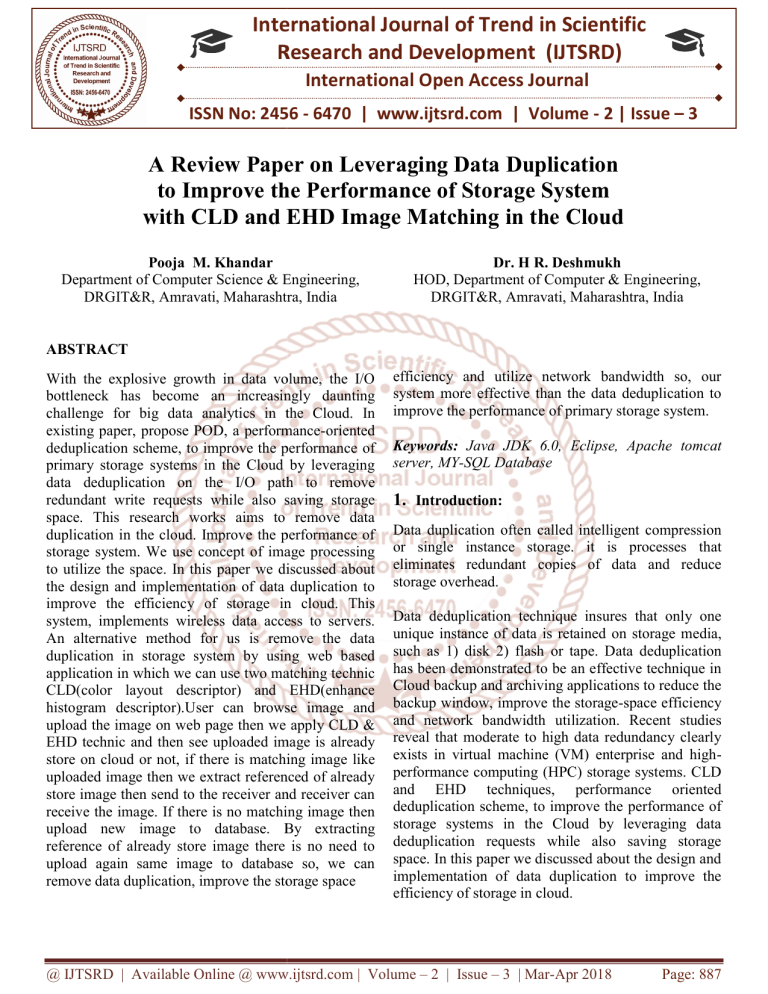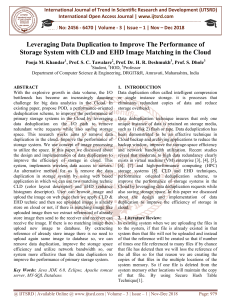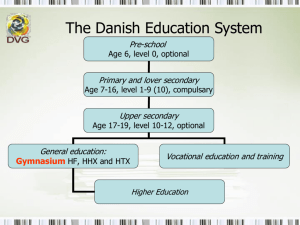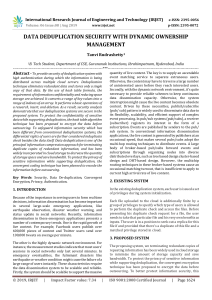
International Journal of Trend in Scientific
Research and Development (IJTSRD)
International Open Access Journal
ISSN No: 2456 - 6470 | www.ijtsrd.com | Volume - 2 | Issue – 3
A Review Paper on Leveraging Data Duplication
to Improve the Performance of Storage System
with CLD and EHD Image Matching in the Cloud
Pooja M. Khandar
Department of Computer Science & Engineering,
DRGIT&R, Amravati, Maharashtra, India
Dr. H R. Deshmukh
HOD, Department of Computer & Engineering,
DRGIT&R, Amravati, Maharashtra, India
ABSTRACT
With the explosive growth in data volume, the I/O
bottleneck has become an increasingly daunting
challenge for big data analytics in the Cloud. In
existing paper, propose POD, a performance
performance-oriented
deduplication scheme, to improve the performance of
primary storage systems in the Cloud by leveraging
data deduplication on the I/O path to remove
redundant write requests while also saving storage
space. This research works aims to remove data
duplication in the cloud. Improve the performance of
storage
ge system. We use concept of image processing
to utilize the space. In this paper we discussed about
the design and implementation of data duplication to
improve the efficiency of storage in cloud. This
system, implements wireless data access to servers.
An alternative method for us is remove the data
duplication in storage system by using web based
application in which we can use two matching technic
CLD(color layout descriptor) and EHD(enhance
histogram descriptor).User can browse image and
upload the image
age on web page then we apply CLD &
EHD technic and then see uploaded image is already
store on cloud or not, if there is matching image like
uploaded image then we extract referenced of already
store image then send to the receiver and receiver can
receivee the image. If there is no matching image then
upload new image to database. By extracting
reference of already store image there is no need to
upload again same image to database so, we can
remove data duplication, improve the storage space
efficiency
y and utilize network bandwidth so, our
system more effective than the data deduplication to
improve the performance of primary storage system.
Keywords: Java JDK 6.0, Eclipse, Apache tomcat
server, MY-SQL Database
1. Introduction:
Data duplication often called intelligent compression
or single instance storage. it is processes that
eliminates redundant copies of data and reduce
storage overhead.
Data deduplication technique insures that only one
unique instance of data is retained on storage media,
such as 1) disk 2) flash or tape. Data deduplication
has been demonstrated to be an effective technique in
Cloud backup and archiving applications to reduce the
backup window, improve the storage-space
storage
efficiency
and network bandwidth utilization.
lization. Recent studies
reveal that moderate to high data redundancy clearly
exists in virtual machine (VM) enterprise and highhigh
performance computing (HPC) storage systems. CLD
and EHD techniques, performance oriented
deduplication scheme, to improve the performance of
storage systems in the Cloud by leveraging data
deduplication requests while also saving storage
space. In this paper we discussed about the design and
implementation of data duplication to improve the
efficiency of storage in cloud.
@ IJTSRD | Available Online @ www.ijtsrd.com | Volume – 2 | Issue – 3 | Mar-Apr
Apr 2018
Page: 887
International Journal of Trend in Scientific Research and Development (IJTSRD) ISSN: 2456-6470
2. Literature Review:
1. A. T. Clements, I. Ahmad, M. Vilayannur, and J.
Li,“Decentralized deduplication in SAN cluster
file systems,” in Proc. Conf. USENIX Annu.
Tech. Conf., Jun. 2009.
2. K. Jinand and E. L. Miller, “The effectiveness of
deduplication onvirtual machine disk images,” in
Proc. The Israeli Exp. Syst. Conf.,
May 2009.
3. D. T. Meyer and W. J. Bolosky, “A study of
practical deduplication,” in Proc. 9th USENIX
Conf. File StroageTechnol.,Feb. 2011.
that way data deduplication closely align with
incremental backup which copies only the data that
has changed since the previous backup.
For example typical e-mail system might contain 100
instances of same 1 MB file attachment if the email
platform is backed up or archived. All 100 instances
are saved, requiring 100 MB of storage space. With
data duplication only one instance of attached stored:
each subsequent instance is referenced back to the one
saved copy therefore in this example 100 MB storage
demands drop to 1MB.
3. IMPLEMENTATION
4. K. Srinivasan, T. Bisson, G. Goodson, and K.
Voruganti, “iDedup: Latency-aware, inline data
deduplication for primary storage, ”in Proc. 10th
USENIX Conf. File Storage Technol., Feb. 2012.
5. A. El-Shimi, R. Kalach, A. Kumar, A. Oltean, J.
Li, and S. Sengupta, “Primary data deduplicationlarge scale study and system design, ”in Proc.
USENIX Conf. Annu. Tech. Conf., Jun. 2012.
6. S. Kiswany, M. Ripeanu, S. S. Vazhkudai, and A.
Gharaibeh,“STDCHK: A checkpoint storage
system for desktop gridcomputing,” in Proc. 28th
Int. Conf. Distrib. Comput. Syst., Jun. 2008.
7. D. Meister, J. Kaiser, A. Brinkmann, T. Cortes,
M. Kuhn, and J. Kunkel, “A study on data
deduplication in HPC storage systems, “in Proc.
Int. Conf. High Perform. Comput., Netw., Storage
Anal., Nov. 2012.
8. X. Zhang, Z. Huo, J. Ma, and D. Meng,
“Exploiting data deduplicationto accelerate live
virtual machine migration,” in Proc. IEEEInt.
Conf. Cluster Comput., Sep. 2010.
Fig 1: flowchart
2. PROPOSED OBJECTIVE
What is data deduplication in cloud computing?
Data duplication often called intelligent compression
or single instance storage. It is process that eliminates
redundant copies of data and reduces storage
overhead. Data deduplication technique insure that
only one unique instance of data is retained on storage
media, such as 1)disk 2) flash or tape Redundant data
block are replace with pointer to a unique data copy in
The following techniques are used in data duplication
to improve the performance of storage system in
cloud.
1. Color layout descriptor(CLD)
2. Edge histogram descriptor(EHD)
@ IJTSRD | Available Online @ www.ijtsrd.com | Volume – 2 | Issue – 3 | Mar-Apr 2018
Page: 888
International Journal of Trend in Scientific Research and Development (IJTSRD) ISSN: 2456-6470
Color layout descriptor:Is designed to capture the spatial distribution of color
in an image .the feature extraction process consist of
two parts;
1. Grid based representative color selection.
2. Discrete cosine transform with contization.
The functionality of CLD is basically the matching
-Image to image matching
-Video clip to video clip matching
Remark that the CLD is one of the most precise and
fast color descriptor
Fig 3: Definition of Sub-image and
Image-block in the EHD
Fig 2: Five Types of Edges in the EHD
4. Technical Specifications And Result Analysis:
Fig 2: color layout descriptor
Edge histogram descriptor:The edge histogram descriptor (EHD) is one of the
widely used methods for shape detection. It basically
represents the relative frequency of occurrence of 5
types of edges in each local area called a sub-image or
image block. The sub image is defined by partitioning
the image space into 4x4Non-overlapping blocks as
shown in figure 1. So, the partition of image definitely
creates 16 equal-sized blocks regardless of the size of
the original image. To define the characteristics of the
image block, we then generate a histogram of edge
distribution for each image block. The edges of the
image block are categorized into 5 types: vertical,
horizontal, 45-degree diagonal, 135-degree diagonal
and non-directional edges, as shown in Figure 2.Thus,
the histogram for each image block represents the
relative distribution of the 5 types of edges in the
corresponding sub-image.
The technologies which are used to implement the
system are:
Java jdk.6.0
Eclipse:In computer programming, Eclipse is an
integrated development environment (IDE). It
contains a base workspace and an extensible plugin system for customizing the environment.
Written mostly in Java, Eclipse can be used to
develop applications. By means of various plugins, Eclipse may also be used to develop
applications in other programming languages:
Ada, ABAP, C, C++, COBOL, Fortran, Haskell,
JavaScript, Lasso, Lua, Natural, Perl, PHP,
Prolog, Python, R, Ruby (including Ruby on Rails
framework), Scala, Clojure, Groovy, Scheme, and
Erlang.
MySQL is open source relational database system.
It is static. Database size is unlimited in MySQL.
MySQL support Java. MySQL does not support
except & intersect operation. MySQL does not
have resource limit. MySQL is available under
GPL
proprietary
license.
The
MySQL
development project has made its source code
available under the term of the GNU General
Public License, as well as under a variety of
proprietary agreements. MySQL is a popular
choice of database for used in web application.
MySQL is written in C and C++.
@ IJTSRD | Available Online @ www.ijtsrd.com | Volume – 2 | Issue – 3 | Mar-Apr 2018
Page: 889
International Journal of Trend in Scientific Research and Development (IJTSRD) ISSN: 2456-6470
6. Advantages:
It requires less storage as it is data duplication
application.
Efficient and fast access.
7. Conclusion:
8. X. Zhang, Z. Huo, J. Ma, and D. Meng,
“Exploiting data deduplicationto accelerate live
virtual machine migration,” in Proc. IEEEInt.
Conf. Cluster Comput., Sep. 2010.
9. www.wikipedia.org/history.
10. http://en.wikipedia.org/wiki
In this paper, we propose CLD and EHD techniques, a
performance oriented deduplication scheme, to
improve the performance of storage systems in the
Cloud by leveraging data deduplication requests while
also saving storage space. In this paper we discussed
about the design and implementation of data
duplication to improve the efficiency of storage in
cloud. This system, implements wireless data access
to servers. An alternative method for us is remove the
data duplication in storage system by using web based
application.
REFERENCES:
1. A. T. Clements, I. Ahmad, M. Vilayannur, and J.
Li,“Decentralized deduplication in SAN cluster
file systems,” inProc. Conf. USENIX Annu. Tech.
Conf., Jun. 2009.
2. K. Jinand and E. L. Miller, “The effectiveness of
deduplication onvirtual machine disk images,” in
Proc. The Israeli Exp. Syst. Conf.,May 2009.
3. D. T. Meyer and W. J. Bolosky, “A study of
practicaldeduplication,” in Proc. 9th USENIX
Conf. File Stroage Technol.,Feb. 2011.
4. K. Srinivasan, T. Bisson, G. Goodson, and K.
Voruganti, “iDedup:Latency-aware, inline data
deduplication for primary storage,”in Proc. 10th
USENIX Conf. File Storage Technol., Feb. 2012.
5. A. El-Shimi, R. Kalach, A. Kumar, A. Oltean, J.
Li, and S. Sengupta,“Primary data deduplicationlarge scale study and system design,”in Proc.
USENIX Conf. Annu. Tech. Conf., Jun. 2012.
6. S. Kiswany, M. Ripeanu, S. S. Vazhkudai, and A.
Gharaibeh,“STDCHK: A checkpoint storage
system for desktop gridcomputing,” in Proc. 28th
Int. Conf. Distrib. Comput. Syst., Jun.2008.
7. D. Meister, J. Kaiser, A. Brinkmann, T. Cortes,
M. Kuhn, andJ. Kunkel, “A study on data
deduplication in HPC storage systems,”in Proc.
Int. Conf. High Perform.Comput., Netw.,
StorageAnal., Nov. 2012.
@ IJTSRD | Available Online @ www.ijtsrd.com | Volume – 2 | Issue – 3 | Mar-Apr 2018
Page: 890




